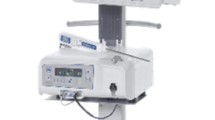Abstract
Aquablation is a novel technique for the surgical management of bladder outlet obstruction secondary to benign prostatic hyperplasia. Following first-in-man studies, a multicenter trial was conducted with results now out to 1 year. Aquablation resulted in a mean International Prostate Symptom Score improvement of 16 points (p < 0.01) and a mean maximum urinary flow rate increase from 8.7 to 18.3 ml/s (p < 0.01) at 12 months. Due to the precise prostate mapping, aquablation has also demonstrated favorable sexual and urinary outcomes with no new erectile dysfunction, retrograde ejaculation, or urinary incontinence as often experienced with other techniques. These improvements in functional outcomes at 12 months confirm that aquablation is a safe and effective alternative for BPH treatment.



Similar content being viewed by others
References
Papers of particular interest, published recently, have been highlighted as: • Of importance •• Of major importance
Parsons JK. Benign prostatic hyperplasia and male lower urinary tract symptoms: epidemiology and risk factors. Current bladder dysfunction reports. 2010;5(4):212–8.
Roehrborn CG. Current medical therapies for men with lower urinary tract symptoms and benign prostatic hyperplasia: achievements and limitations. Reviews in urology. 2008;10(1):14.
• Robert G, Cornu JN, Fourmarier M, Saussine C, Descazeaud A, Azzouzi AR, et al. Multicentre prospective evaluation of the learning curve of holmium laser enucleation of the prostate (HoLEP). BJU Int. 2016;117(3):495–9. This paper outlines the difficulties with the HoLEP learning curve.
•• MacRae C, Gilling P. How I do it: aquablation of the prostate using the AQUABEAM system. Can J Urol. 2016;23(6):8590. A complete description of the Aquablation technique.
Papachristou DN, Barters R. Resection of the liver with a water jet. Br J Surg. 1982;69(2):93–4.
Baer HU, Stain SC, Guastella T, Maddern GJ, Blumgart LH. Hepatic resection using a water jet dissector. HPB Surg. 1993;6(3):189–98.
Rau HG, Buttler E, Meyer G, Schardey HM, Schildberg FW. Laparoscopic liver resection compared with conventional partial hepatectomy—a prospective analysis. Hepato-Gastroenterology. 1997;45(24):2333–8.
Piek J, Oertel J, Robert Gaab M. Waterjet dissection in neurosurgical procedures: clinical results in 35 patients. J Neurosurg. 2002;96(4):690–6.
Hubert J, Mourey E, Suty JM, Coissard A, Floquet J, Mangin P. Water-jet dissection in renal surgery: experimental study of a new device in the pig. Urol Res. 1996;24(6):355–9.
Shekarriz H, Shekarriz B, Bürk CG, Kujath P, Bruch HP. Hydro-jet–assisted pneumonectomy: a new technique in a porcine model. Journal of Laparoendoscopic & Advanced Surgical Techniques. 2002;12(5):371–6.
Shekarriz H, Shekarriz B, Upadhyay J, Bürk C, Bruch HP, Wood DP Jr. Hydro-jet assisted laparoscopic partial nephrectomy: initial experience in a porcine model. J Urol. 2000;163(3):1005–8.
Nagele U, Kugler M, Nicklas A, Merseburger AS, Walcher U, Mikuz G, et al. Waterjet hydrodissection: first experiences and short-term outcomes of a novel approach to bladder tumor resection. World J Urol. 2011;29(4):423–7.
Faber K, de Abreu ALC, Ramos P, Aljuri N, Mantri S, Gill I, et al. Image-guided robot-assisted prostate ablation using water jet-hydrodissection: initial study of a novel technology for benign prostatic hyperplasia. J Endourol. 2015;29(1):63–9.
Gilling P, Reuther R, Kahokehr A, Fraundorfer M. Aquablation–image-guided robot-assisted waterjet ablation of the prostate: initial clinical experience. BJU Int. 2016;117(6):923-929.
Cornu JN, Ahyai S, Bachmann A, de la Rosette J, Gilling P, Gratzke C, et al. A systematic review and meta-analysis of functional outcomes and complications following transurethral procedures for lower urinary tract symptoms resulting from benign prostatic obstruction: an update. Eur Urol. 2015;67(6):1066–96.
Montorsi F, Naspro R, Salonia A, Suardi N, Briganti A, Zanoni M, et al. Holmium laser enucleation versus transurethral resection of the prostate: results from a 2-center, prospective, randomized trial in patients with obstructive benign prostatic hyperplasia. J Urol. 2004;172(5):1926–9.
Ahyai SA, Gilling P, Kaplan SA, Kuntz RM, Madersbacher S, Montorsi F, et al. Meta-analysis of functional outcomes and complications following transurethral procedures for lower urinary tract symptoms resulting from benign prostatic enlargement. Eur Urol. 2010;58(3):384–97.
Sturch P, Woo HH, McNicholas T, Muir G. Ejaculatory dysfunction after treatment for lower urinary tract symptoms: retrograde ejaculation or retrograde thinking. BJU Int. 2015;115(2):186–7.
Author information
Authors and Affiliations
Corresponding author
Ethics declarations
Conflict of Interest
Omid Yassaie, Joshua A. Silverman, and Peter J. Gilling each declare no potential conflicts of interest.
Human and Animal Rights and Informed Consent
This article does not contain any studies with human or animal subjects performed by any of the authors.
Additional information
This article is part of the Topical Collection on Benign Prostatic Hyperplasia
Rights and permissions
About this article
Cite this article
Yassaie, O., Silverman, J.A. & Gilling, P.J. Aquablation of the Prostate for Symptomatic Benign Prostatic Hyperplasia: Early Results. Curr Urol Rep 18, 91 (2017). https://doi.org/10.1007/s11934-017-0743-2
Published:
DOI: https://doi.org/10.1007/s11934-017-0743-2




